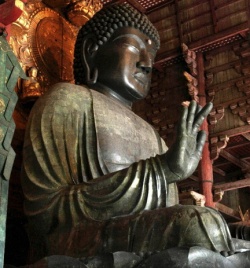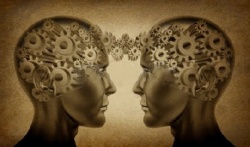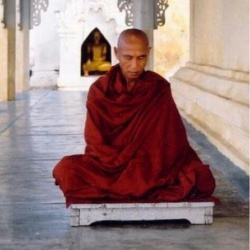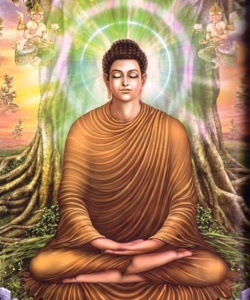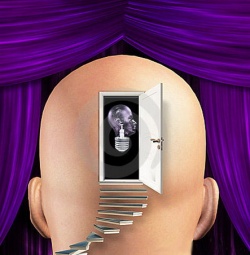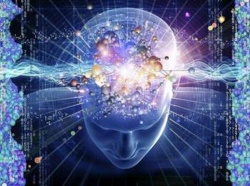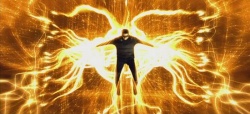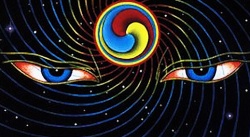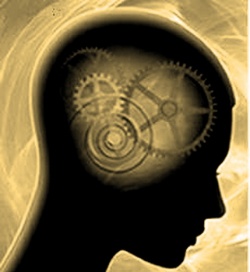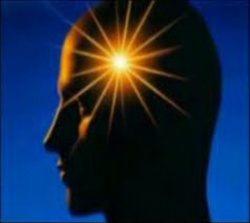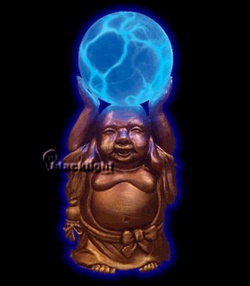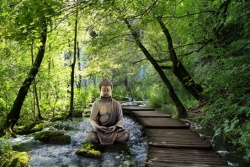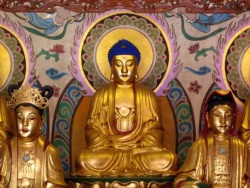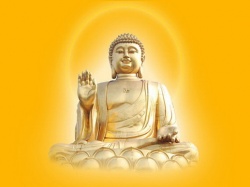Dharma Talk: Consciousness and Quantum Physics
On the last day of the Retreat for Scientists in the Field of Consciousness, Thây gave this dharma talk explicating the Verses on the Characteristics of the Eight Consciousnesses. This material will be included in a new book by Thich Nhat Hanh slated for publication in March 2007 by Parallax Press, Buddha Mind, Buddha Body.
Today we will go over the Verses on the Characteristics of the Eight Consciousnesses.Before that I would like to remind everyone of a few key words.
Modes of Cognition, Objects of Cognition, Moral Natures
The three modes of cognition are direct, inference, and fallacy, which is a wrong form of direct perception or inference.
The three objects of cognition are suchness, the thing in itself, which is accessed by direct cognition; representations, in which you create the object of your perception, for a mental interpretation of reality; and mere images; such as those we see in dreams. Mere images make up the majority of the objects of our mind consciousness.
The three moral natures of cognition are wholesome, which means having the capacity to induce wisdom, compassion, and liberation; unwholesome, leading us in the direction of delusion and unhappiness; and indeterminate, neither wholesome nor unwholesome, but malleable.
The first five consciousnesses — ear, eye, nose, tongue, and body consciousness — have access to suchness. This sensory consciousness can touch the one-instant reality, which has no duration in time, no extension in space. Those are the materials with which mental consciousness translates and creates the world. But this suchness is on the side of the phenomenal, not the noumenal. The eighth consciousness — store consciousness — has access to the realm of phenomenal suchness as well as noumenal suchness.
The five use the direct mode of cognition, which is why they can have access to reality in itself, suchness. The eighth also uses a direct mode of cognition — no induction, no deduction, no inference. That is why in the store there is innate, non-discriminative basic wisdom.
Now we speak of the seventh, which is manas, the self center. Manas represents grasping, loving, appropriating. We call it “the lover” in Vietnamese, the consciousness of love, but this is not true love because there is delusion in it. In the seventh consciousness there are four basic afflictions: self-delusion, self-love, self-view, and self-conceit. The basic illusion inherent in all four afflictions is the illusion about self: this body is mine, is me; this feeling is me; these emotions are me; this consciousness is me and I am independent from everything else. We call manas the lover, and the victim is of course the eighth consciousness.
Manas has a tendency to seek pleasure and avoid pain, ignoring the goodness of suffering and moderation, ignoring interbeing and impermanence. That is why the mode of cognition of the seventh is fallacy. The object of its cognition is not suchness, it is an image created by self that carries a little core of reality — a representation.
When I was a novice, my teacher taught me that manas is born from a seed in store consciousness, manifests as a consciousness, and bends down to embrace one part of the store. This area of interference becomes the object of the seventh consciousness. Manas is the lover and it is grasping its loved one, just one part of it. It’s looking at reality with glasses colored by attachment and love. That zone of interference is the very object of manas — a self. The practice is to free the eighth from manas so it becomes the Wisdom of Great Mirror.
Imagining the Eighth Consciousness
Store has a triple meaning. Suppose you have a museum of art. You have a building, which stores all the precious things that are inside. The museum is not only the building, it is also what is in the building. So store has at least two meanings: the house that keeps what is inside, and also the contents. But there is also someone who lives in the building. His title is the museum keeper, and he thinks the museum belongs to him. The museum is an object of love, and the lover is the museum keeper.
Our Chinese friends use the image of a young lady who is pregnant. She is the storer and the baby is the object of storing. So you have the two meanings: storing and being stored. But there is someone who appropriates, and that is the husband of the lady, the father of the baby, and he considers this store as his. That is why store is not free. You can’t move freely because you are owned by someone.
The moral nature of the eighth is indeterminate. It is neither good nor evil, neither wholesome nor unwholesome. In Chinese the word means plasticity; it can be changed. It is neutral, indeterminate, but it is not hidden, veiled. It is not hidden by delusion.
The seventh also has the nature of plasticity. It is also indeterminate because it can be changed. But its nature is veiled.
The five, when they operate alone, without the collaboration of the sixth, also have an indeterminate nature. The true nature of reality is neither wholesome nor unwholesome. It is us who make it wholesome or unwholesome, as with a knife. If you use the knife to cut vegetables and cook for a community, it is wholesome. If you use it to kill, it is unwholesome. In its nature it is indeterminate.
We have not spoken about the sixth, but it has the capacity to reach out to all three modes of cognition. The sixth has access to the realm of suchness, the realm of representation, and the realm of mere image. The seventh does not have access to the realm of mere image. The sixth also can be wholesome, unwholesome, or indeterminate. So the sphere of activity of the sixth is the broadest.
Verses on the Characteristics of the Eight Consciousnesses
When I was a novice monk I had to memorize the Chinese text. We can go through this very easily.
Verse on the Final Five Consciousnesses
“The object of the first five consciousnesses is the sphere of nature (suchness), their mode of cognition is direct, and their nature can either be wholesome, unwholesome, or neutral. In the Second Land, only eye consciousness, ear consciousness, and body consciousness operate.” This is the land of pure form, where there are other kinds of nutriments and we don’t need edible food. That is why you don’t use your nose and your tongue. It is much easier, you don’t have to kill each other to get food! We don’t need to talk much about the Second Land.
“The five sense consciousnesses operate with the five Universals, the five Particulars, the eleven Wholesome mental formations, the two Middle Secondary Unwholesome mental formations (lack of inner shame, lack of shame before others), the eight Greater Secondary mental formations, and with craving, hatred, and confusion.” That is because they collaborate with the sixth. We have a list of mental formations to refer to, so we know what mental formations can operate together.
“All five consciousnesses operate on the ground of Pure Matter Organs…” This is the nervous system and the sensory systems. There are gross organs like ears or eyes but the five consciousnesses are based on a more subtle sense organ — the central nervous system, the sensory systems.
The “nine, eight or seven conditions” are absolutely necessary for the five consciousnesses to manifest. For all five the first condition is the seed in consciousness, because all of them spring from a seed in store consciousness. Store consciousness is another base.
The five consciousnesses are based on the seventh consciousness, because the seventh consciousness is the foundation of good and evil. If they are good or evil in their way of perceiving it is because of the seventh, manas. The next condition is mind consciousness; it is like the water and the five sensory consciousnesses are like the waves, where water is the base for the waves. The other conditions are attention, space, and light. While eyes need light to operate, the nose and ear do not need light. There are nine conditions; some of the sense organs need all nine, some only seven or eight.
“They observe the world of dust [the phenomenal world); two of them from a distance, three from direct contact.” Two of them are ear consciousness and eye consciousness. “Naïve people find it difficult to distinguish between organ and consciousness.” It is not the eyes that see things; the eyes are only one condition.
“It is thanks to Later Acquired Wisdom that the five consciousnesses could contemplate emptiness in its manifested forms.” Even after you become a Buddha, only the basic innate wisdom has access to the noumenal world, while the five touch only the phenomenal world. “Therefore even after enlightenment, the five consciousnesses by themselves are still not capable of reaching out to true emptiness.” True emptiness here is the noumenal, the ontological ground of reality. Only the eighth has access to it, because the eighth has the Wisdom of the Great Mirror — innate wisdom. What we get by our studies, discursive thinking, and meditation, is the Later Acquired Wisdom, which does not have access to the ontological ground. You cannot see God with your eyes.
“When the eighth consciousness is transformed into the Great Mirror Wisdom, the five sense consciousnesses can attain the state of ‘no-leaking’.” No leaking means you don’t fall down anymore. “Thereupon, the three types of manifestation bodies are available to help us end the cycle of suffering in the world.” The first body is a beautiful body that can be recognized by bodhisattvas; when you teach to a bodhisattva, the bodhisattva sees this beautiful body of yours. The second body is like the body of Shakyamuni, a regular human being, which all of us can see. The third kind is any body that can bring about a teaching. It can be a politician, a businessman, a man, a woman, a child, but if it can help people to transform, it is a third body of the Buddha.
Verse on the Sixth Consciousness
“The sixth consciousness can be easily observed when it operates in the three natures, the three modes of cognition, and the three kinds of objects of cognition, and when it still goes around in the three realms.” These are the realms of desire, fine or subtle form, and no form. According to Buddhist wisdom, life is possible in the realm of no form and no matter. Many people who are about to die and come back to life report that they see light; that may be the realm of pure light. This is an invitation for our scientists: besides matter there is life. Life is expressed not only in terms of matter, it can be expressed in other forms — energy, light, and so on.
“This consciousness operates with all the fifty-one mental formations. Whether wholesome or unwholesome, its nature depends on times and occasions.” If you live in a good environment there are many chances for mind consciousness to be wholesome. When the good seeds are watered every day you are able to proceed in a more positive direction.
“Related to the sixth consciousness, the three natures, the three realms, and the three feelings are in permanent transformation and change. The six Primary Unwholesome mental formations, the twenty Secondary Unwholesome mental formations, and the eleven Wholesome mental formations (such as faith, etc.) all are related.” Mind consciousness operates with all mental formations.
“Even when the practitioner enters the Land of Joy with her bodhisattva’s beginner’s mind, the innate attachment to a self still lies dormant in the depths of her consciousness.” In the Land of Joy there is quite a lot of happiness and peace, but manas has not been transformed profoundly. That is why the sixth consciousness is still bound. In the depth of consciousness that innate attachment to a self still exists. “It is only when she reaches the Seventh Land, called the Land of Far Reaching, that this consciousness is free from ‘leaks’.” It does not go down anymore, it can stay there or go up; that is the state of no-leaking. There may be ups but there is no down anymore.
“At this time, the sixth consciousness becomes the Wisdom of Wonderful Contemplation, illuminating the whole cosmos.” When the seventh is transformed the sixth is also totally transformed.
Verse on the Seventh Consciousness
“Obscured, with an object that carries some substance linking the Lover and the Base, the seventh consciousness always follows and clings to the Base as a self. Its mode of cognition is erroneous. It operates with the five Universals, the eight Greater Secondary mental formations, with mati (one of the five Particulars) and with self-love (craving), self-delusion (ignorance), self-view ([wrong] view), and self-conceit (arrogance).”
With the practice, the seventh consciousness, manas, can be transformed into the wisdom of non-discrimination and equanimity. But now it is veiled, obscured.
“Continuously following and grasping the object of self, this consciousness induces the state of dreaming and confusion in living beings day and night. The four afflictions and the eight Greater Secondary mental formations always manifest and operate with the seventh consciousness. This consciousness is also called the ground of defilement and purity for the other six evolving consciousnesses.” The seventh serves as the foundation of wholesomeness and unwholesomeness for the other six consciousnesses.
We see here the expression “evolving consciousness”; all the seven consciousnesses are described as evolving. The eighth consciousness is described as the ocean. When there is a wind blowing, the seventh consciousness manifests as waves. In the sutra it is said that store consciousness is like the ocean because when the wind of the objects blows, the seven consciousnesses are born dancing. That is the image used by the Buddha: the dancing of the seven consciousnesses.
“When the practitioner reaches the Land of Extreme Joy, the nature of equanimity begins to reveal itself.” Equanimity means no discrimination. You don’t distinguish any more between self and nonself. I am in you and you are in me. “When he arrives at the Eighth Land, the Land of Effortlessness, the illusion of self is gone. At this time, the Tathagatha manifests His body for the sake of others, and all the bodhisattvas of the ten lands benefit from his presence.” With the attainment of no-self, your power to help people becomes immense.
Verse on the Eighth (Store) Consciousness
“With its indeterminate (and non-obscuring) nature, the eighth consciousness operates with the five Universals.” The five Universals are contact, attention, feelings, perception, and volition. Volition is the motor of consciousness, the willingness to respond, to act. These five are universal because they are the basis of all consciousness.
“Realms and Lands depend on karmic power.” Whether you live in the realm of desire, of fine form, or of no form depends on your actions. Lands here means the ten lands of the practitioner. In the beginning with your practice you arrive at the Land of Joy, of happiness, and you continue to the second land, the third land, until you arrive at the tenth land and become a Buddha. You have Buddhahood innate in you.
“People belonging to the lesser Vehicles do not know about the eighth consciousness because of their attachment and wrong views. It is for this reason that they still debate about its presence.” When we speak of the subconscious of Freud and the collective unconscious of Jung, we speak of one part of store consciousness. But store consciousness is much larger.
“How immense is the Unfathomable Triple Store!” We have spoken about the triple store aspect — the storing, what is stored, and the object of grasping. “From the deep ocean of the Store arise the seven waves of the seven evolving consciousnesses, the wind being the object of their cognition! This consciousness receives impregnation, preserves all seeds and also the body, organs and environment.” This is a very important sentence. The word is translated as “impregnation” here but in terms of thought processes it is learning, apprenticing, computing. That is the word vasana, perfuming.
The image they use in the sutra is tea. If you want to have jasmine tea you put jasmine flowers into a tea box for a few nights. The jasmine scent penetrates the tea and you have jasmine tea. For lotus tea, the people in Vietnam used to go to the lotus pond in the early afternoon in a small boat, and insert a small quantity of tea into each lotus flower. At six or seven o’clock the lotus flower closes and during the whole night the tea gets impregnation from the lotus flavor. In the morning they bring hot water and a tea pot to the middle of the lotus pond, they recover the tea from the lotus flower, and they have lotus tea. That is a very poetic way of having tea. People now are too busy to do that; they call it a waste of time. Time is to make money, not to do things like that.
The word vasana means impregnation, learning, processing. Because the consciousness is plastic, it can be conditioned. If we have habit energies and patterns of behavior, that is because of vasana. We develop those during the first six years of our life and we continue to do that.
The eighth preserves all the seeds, and of course memory, images, and all experience, and all the organs also. This body is maintained in life by store consciousness. What the neuroscientists call background consciousness is only something manifested together with the body.
In psychology we only speak of the first type of seeds: they manifest in mind consciousness as mental formations. There are fifty-one mental formations. The body with its five organs is the fruit of our retribution, and it has also come from store. The environment, which is another aspect of manifestation, is another aspect of our retribution. In Buddhism please remember that our retribution is double: we ourselves and our environment. People around you are part of you and part of your retribution. You get what you deserve. If you have a president like that, that’s your karma, you have created him or her. He is born from your store consciousness, somehow, more or less collectively.
“It is the one who comes first and leaves last, being truly a master of the house!” This is speaking about the energy that animates the body. A living body always has store consciousness in it. When the body deteriorates, that manifestation withdraws at the same time, but returns to the seed in order to manifest again and again, like the earth. The earth brings us to life, the earth receives us back, and the earth will bring us out again. So life after life. That is the meaning of continuation, of rebirth. The rebirth of our body is linked to the rebirth of our environment. So this is the base, and that is why we call it basic consciousness.
In Western psychology, the subconscious is only background consciousness and actor consciousness. Background consciousness is part of the store and actor consciousness is part of the mind consciousness. But the store consciousness is much larger — it is immense. We need to think of store in terms of collective store and individual store.
Quantum Coherence in Practice
There is nothing complicated here! I think we have to establish the link between biology and quantum physics. One day we should have a unified vision, from cell we go to molecules but we have to go further, all the way to a quantum mechanical description involving fundamental particles or energies. Quantum properties may be detected in consciousness and in the brain. In our practice, every time we sit together and breathe together we come into phase and we create a coherence among ourselves or a holistic property of the sangha. Every time we become mindful of the bell and the breath, we are no longer separated from each other; we become one, all one organism. When we walk, if everyone is breathing and walking together, we lose our boundaries and we become something much more powerful. We can experience that in our practice.
Quantum coherence has been detected by neuroscientists. They have discovered that biological tissues, when they are excited with the right energy level, begin to emit a tiny glow. We know that there are a multitude of molecules of fat and proteins in the membrane of each cell. They are truly electromagnetic dipoles.
When a cell is at rest, these molecules of fat and proteins have their dipoles arranged in a haphazard way. They are out of phase. But when there is stimulation, they begin to jiggle intensively and oscillate in unison. One molecule behaves like the totality of all molecules. You begin to see the holistic property of a Bose- Einstein condensate.
Einstein predicted with mathematics that when we are able to bring the atoms of a substance down in temperature to near absolute zero, every particle behaves like the totality. Every particle loses its boundary and occupies the whole of time and space in that place. It is possible to use laser beams to bombard these particles to bring them down to a temperature very close to absolute zero. Scientists have been able to do that with certain gases and liquids, including gases of sodium and ribidium, and liquid helium. That is what Einstein called a Bose-Einstein condensate (named for Indian physicist Satyendra Nath Bose and Albert Einstein).
Einstein said that we can make the particles sing in unison. The one behaves like the totality and the totality can be seen in the one. We learn that in the case of a laser beam, all the photons in the laser beam behave holistically, they don’t have their own boundaries anymore. They behave just like one photon, similar to a Bose-Einstein condensate.
We don’t need to bring our brain down to a temperature near absolute zero. At body temperature we can observe behavior analogous to quantum properties, quantum coherence. This is very promising.
When the cell is excited with the right energy level, all the electrical dipoles come together and begin to oscillate together, to sing in unison. In Plum Village we try to imitate that model, when we sit and listen to the bell, when we walk, when we chant. We try to lose our boundaries and be just one. We try to create quantum coherence in our practice. This environment is very nourishing and healing.
When all the dipoles of these molecules come together and oscillate together, it sounds like beautiful music. They are in phase. They are suddenly coordinated. The practice of mindfulness and concentration can induce our brain to create such states of being. We can practically hold the brain circuits in a coherent place with our practice of breathing and walking. We can maintain that with samadhi or concentration. Samadhi means to hold at the same level, not off and on, off and on, but always on and at the same level.
Knowing That You Don’t Know
We can practice looking deeply in order to get insight. That kind of peace, harmony, and insight can be downloaded to the store. If we continue we can erase the wrong programs. We can rewire how the brain works. Transformation is possible with the work of mind consciousness because mind consciousness is the gardener. It has the power of the gardener and it can take care of the garden. With the process of relearning and reprocessing, we can create positive beautiful patterns of behavior. Peace, harmony, and insight can transform the store, transform manas, and free mind consciousness. They free store consciousness totally.
Teachers throughout Buddhist history have tried their best to create means to help us understand. This kind of teaching does not aim at describing the truth, but aims at helping you to practice. If you are good practitioners you may be able to improve how truth is described and presented.
There is much in common between the practice of Buddhism and science. In Buddhism people stress that we should not cling to our notions, our truth, especially when our truth is described conceptually, because then we have not arrived at the deeper truth. Of course in Buddhism we have to use concepts and words but we are warned by the Buddha not to be caught in them; we should be ready to release what we know. To say “I don’t know” is very positive.
Confucius said something like this: The moment you say I don’t know, you begin to know. If you don’t know and you say you know, you don’t know anything. So “I do not know” is a very good practice.
Dharma Rain
Well, seven days is not much! But it has been a wonderful opportunity to come together to focus on a very important topic. It has been wonderful to walk, sit, breathe with you, to receive the dharma as rain, to laugh, to look at each other. It is my deepest hope that you can continue at home the practice of breathing and walking mindfully. And if I’m still around in 2008 let us come together for a t wenty-one-day retreat with the title “The Brain of the Buddha.”
Please take Plum Village home with you in your heart. We need you to smile and breathe mindfully. If you can do that, space and time will no longer be obstacles.
Transcribed and edited by Janelle Combelic, with help from proofreader Elaine Hild, quantum physicist Ray Simmonds, and Sister Annabel, True Virtue.
The Verses on the Characteristics of the Eight Consciousnesses
by Master Hsüan-Tsang (c.a. 596-664 A.D.) of the Tang Dynasty in China
Translated from Chinese by Thich Nhat Hanh
Verse on the First Five Consciousnesses
The object of the first five consciousnesses is the sphere of nature, their mode of cognition is direct, and their nature can either be wholesome, unwholesome or neutral. In the Second Land, only eye consciousness, ear consciousness and body consciousness operate. The five sense consciousnesses operate with the five Universals, the five Particulars, the eleven Wholesome mental formations, the two Middle Secondary Unwholesome mental formations (lack of inner shame, lack of shame before others), the eight Greater Secondary mental formations, and with craving, hatred, and confusion.
All five consciousnesses operate on the ground of Pure Matter Organs, depending on nine, eight or seven conditions. They observe the world of dust; two of them from a distance, three from direct contact. Naïve people find it difficult to distinguish between organ and consciousness.
It is thanks to Later Acquired Wisdom that the five consciousnesses could contemplate emptiness in its manifested forms. Therefore even after enlightenment, the five consciousnesses by themselves are still not capable of reaching out to true emptiness. When the eighth consciousness is transformed into the Great Mirror Wisdom, the five sense consciousnesses can attain the state of “no-leaking”. Thereupon, the three types of manifestation bodies are available to help us end the cycle of suffering in the world.
Verse on the Sixth Consciousness
The sixth consciousness can be easily observed when it operates in the three natures, the three modes of cognition, and the three kinds of objects of cognition, and when it still goes around in the three realms. This consciousness operates with all the fiftyone mental formations. Whether wholesome or unwholesome, its nature depends on times and occasions.
Related to the sixth consciousness, the three natures, the three realms, and the three feelings are in permanent transformation and change. The six Primary Unwholesome mental formations, the twenty Secondary Unwholesome mental formations, and the eleven Wholesome mental formations (such as faith etc.) all are related. The sixth consciousness constitutes the main dynamic force for speech and action that will determine future retribution in both general and particular terms.
Even when the practitioner enters the Land of Joy with her bodhisattva’s beginner’s mind, the innate attachment to a self still lies dormant in the depths of her consciousness. It is only when she reaches the Seventh Land, called the Land of Far Reaching, that this consciousness is free from “leaks”. At this time, the sixth consciousness becomes the Wisdom of Wonderful Contemplation, illuminating the whole cosmos.
Verse on the Seventh Consciousness
Obscured, with an object that carries some substance linking the Lover and the Base, the seventh consciousness always follows and clings to the Base as a self. Its mode of cognition is erroneous. It operates with the five Universals, the eight Greater Secondary mental formations, with mati (one of the five Particulars) and with self love (craving), self delusion (ignorance), self view ([wrong] view), and self conceit (arrogance).
Continuously following and grasping the object of self, this consciousness induces the state of dreaming and confusion in living beings day and night. The four afflictions and the eight Greater Secondary mental formations always manifest and operate with the seventh consciousness. This consciousness is also called the ground of defilement and purity for the other six evolving consciousnesses.
When the practitioner reaches the Land of Extreme Joy, the nature of equanimity begins to reveal itself. When he arrives at the Eighth Land, the Land of Effortlessness, the illusion of self is gone. At this time, the Tathagatha manifests His body for the sake of others, and all the bodhisattvas of the ten lands benefit from his presence.
Verse on the Eighth (Store) Consciousness
With its indeterminate (and non-obscuring) nature, the eighth consciousness operates with the five Universals. Realms and Lands depend on karmic power. People belonging to the lesser Vehicles do not know about the eighth consciousness because of their attachment and wrong views. It is for this reason that they still debate about its presence.
How immense is the Unfathomable Triple Store! From the deep ocean of the Store arise the seven waves of the seven evolving consciousnesses, the wind being the object of their cognition! This consciousness receives impregnation, preserves all seeds and also the body, organs and environment. It is the one who comes first and leaves last, being truly a master of the house!
Before arriving at the Land of Immovability, the function of the eighth consciousness is abandoned. After reaching the Diamond Path, there is no more retribution. The Great Mirror Wisdom and the Immaculate Consciousness appear at the same time, illuminating the innumerable Buddha fields in the ten directions.
The Fifty-One Mental Formations
- Five Universals
- contact
- attention
- feeling
- perception
- volition
- Five Particulars
- intention
- determination
- mindfulness
- concentration
- insight
- Eleven Wholesome
- faith
- inner shame
- shame before others
- absence of craving
- absence of hatred
- absence of ignorance
- diligence, energy
- tranquility, ease
- vigilance
- equanimity
- non harming
- Wholesome (added by Thây)
- non fear
- absence of anxiety
- stability, solidity
- loving kindness
- compassion
- joy
- humility
- happiness
- feverlessness
- freedom/sovereignty
- Six Primary Unwholesome
- Twenty Secondary Unwholesome
- Ten Minor Secondary Unwholesome
- anger
- resentment, enmity
- concealment
- maliciousness
- jealousy
- selfishness, parsimony
- deceitfulness, fraud
- guile
- desire to harm
- pride
- Two Middle Secondary Unwholesome
- lack of inner shame
- lack of shame before others
- Eight Greater Secondary Unwholesome
- restlessness
- drowsiness
- lack of faith, unbelief
- laziness
- negligence
- forgetfulness
- distraction
- lack of discernment
- Unwholesome (added by Thây)
- fear
- anxiety
- despair
- Four Indeterminate
- regret, repentance
- sleepiness
- initial thought
- sustained thought


